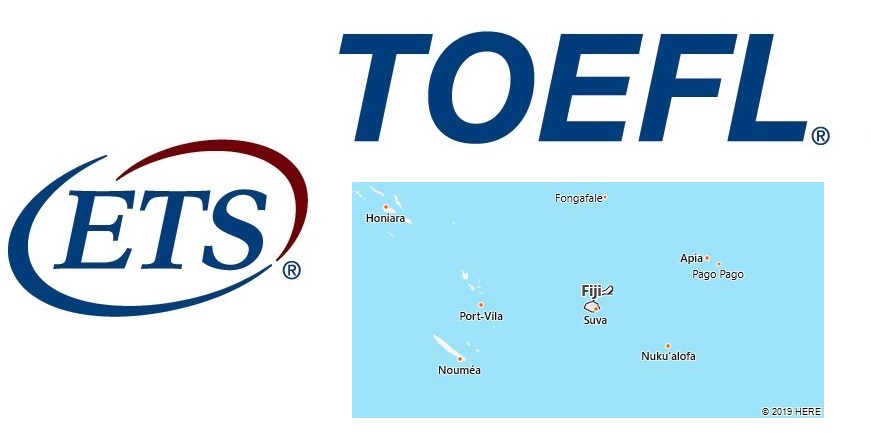The revised TOEFL Paper-delivered Test is offered in this location.
The list below shows testing regions, fees and dates as of February 15, 2019, but availability may change when you register. Fees are shown in US$ and are subject to change without notice.
| Region | Testing Format | Fee | Test Dates |
|---|---|---|---|
| Suva (Code: U150) | TOEFL Paper Testing | $180 $180 $180 $180 |
Sat., Oct 13, 2018 Sat., Nov 10, 2018 Sat., Feb 09, 2019 Sat., Apr 13, 2019 |
Fiji Overview
Fiji, a state in the southwestern Pacific Ocean that includes the Fiji Islands and Rotuma Island. Of the roughly 844 volcanic and coral islands, only 110 are inhabited. About 61% of the population are native Fijians (Melanesians), 32% Indians (formerly brought into the country by the British as sugar cane workers). Sugar cane, bananas, pineapples, coconut oil and gold are the main export goods. The most important source of foreign exchange, however, is tourism.
History: Discovered in 1643, the islands became a British crown colony in 1874. In 1970 they were given independence as a parliamentary monarchy under the Commonwealth. In 1987, after a military coup, the republic was proclaimed.
Country facts
- Official name: Republic of Fiji
- License plate: FJI
- ISO-3166: FJ, FJI (242)
- Internet domain:.fj
- Currency: 1 Fijian dollar ($ F) = 100 cents
- Area: 18,270 km²
- Population (2019): 890,000
- Capital: Suva
- Official language (s): English, Hindi, Fijian
- Form of government: Parliamentary republic
- Administrative division: 4 districts and 1 administrative area with special status
- Head of State: President Jioji Konrote (since November 12, 2015)
- Head of Government: Frank Bainimarama (since September 22, 2014)
- Religion (s) (2007): Christians (45% Protestants; 9% Catholics, 10% other Christians); 28% Hindus, 6% Muslims, 2% other / n / a
- Time zone: Central European Time +11 hours
- National holiday: October 10th
Location and infrastructure
- Location (geographical): Oceania
- Location (coordinates): between 15 ° and 22 ° south latitude, 177 ° west longitude and 175 ° east longitude
- Climate: Tropical-maritime climate
- Highest mountain: Tomanivi (1324 m)
- Road network (2011): 1,686 km (paved), 1,754 km (unpaved)
- Railway network (2008): 597 km
Population
- Annual population growth (2021): 0.5%
- Birth rate (2021): 16.9 per 1000 inh.
- Death rate (2021): 6.3 per 1000 pop.
- Average age (2020): 29.9 years
- Average life expectancy (2021): 74 years (women 76.8; men 71.3)
- Age structure (2020): 26.9% younger than 15 years, 7.3% older than 65 years
- Literacy rate (15 year olds and older) (2018): 99.1%
- Mobile phone contracts (pre-paid and post-paid) (2017): 118 per 100 pop.
- Internet users (2017): 50 per 100 residents.
Economy
- GDP per capita (2019): US $ 6 043
- Total GDP (2019): US $ 5.407 billion
- GNI per capita (2019): US $ 5,800
- Education expenditure (2013): 3.9% of GDP
- Military expenditure (2019): 1.6% of GDP
- Unemployment rate (15 years and older) (2019): 4.1%
Fiji, official name: English Republic of Fiji [r ɪ p ʌ bl ɪ k əv fi ː d ʒ i ː ], Fijian Na Matanitu ko Viti, German Fiji, island nation in the southwest Pacific, on the borderline between Melanesia and Polynesia belongs (mostly to Melanesia), east of Australia, between Vanuatu (Melanesia) in the west and Tonga (Polynesia) in the east, with (2019) 890,000 residents; The capital is Suva.
Fiji comprises the group of Fiji Islands with 844 islands, of which around 332 are larger islands, 110 of which are inhabited, and the island of Rotuma as an outer area (special status).
Location
The archipelago consists of a total of 844 islands (with tiny islands, reefs and atolls), the largest are Viti Levu (10,429 km 2), Vanua Levu (5 556 km 2) and Taveuni (435 km 2).
They consist of old rocks overlaid by young volcanic cones (in Tomanivi on Viti Levu up to 1,324 m above sea level). The flat, densely populated coastal areas are lined with mangroves and coral reefs. Separated from the large islands by the Nanuku Passage, the Lau group is located in the east, among others. smaller islands, which are mainly made up of coral limestone and reefs. The whole archipelago is shaped like a horseshoe around the Koro Sea.
Climate and vegetation
The climate is tropical. On the south-east side of the islands there is a long-term average precipitation of over 3,000 mm (rainforest with valuable wood) in the windward direction from warm, humid trade winds, the leeward sides (annual average precipitation 1,500 mm) are mostly covered with savannah and grassland (cattle breeding). Lower areas are mostly cultivated; they only have a few sparse forests on deeply weathered, humus-rich soils that are suitable for tropical agriculture (sugar cane, pineapple, coconut palms). There are well-developed river systems on the large islands (Rewa on Viti Levu, Ndreketi on Vanua Levu and others).

